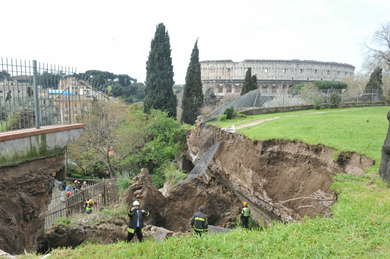Situation 'of extreme alarm', commissioner says
© ANSA
Rome - Part of the ceiling of Roman Emperor Nero's Domus Aurea collapsed on Tuesday.
Some 60 square meters of the baths built on top of the Golden House by the emperor who succeeded Nero, Trajan, came down because of seepage from recent heavy rains, civil protection experts said.
The area where the collapse occurred, a tunnel that was once part of the baths, has been cordoned off because it is close to the entrance to public gardens above it, they said.
"Now we're trying to seal it off so no more rain will get into the hole," they said. Rome Mayor Gianni Alemanno said he was "very worried" about the state of the structure, one of Rome's most celebrated tourist attractions.
The special commissioner for the site, Luciano Marchetti, said "more collapses were possible". The situation, he said, is "one of extreme alarm".
The Domus Aurea, built by Nero soon after the great fire in Rome in 64 AD, has been shut since 2005 for work to make it more stable.
It was closed after masonry fell from flaking walls and a high level of dangerous seepage was detected.
The current project aims to open up 2,600 square metres of the site.
The top of the Domus on the Colle Oppio (Oppian Hill) is covered with parks, trees and roads whose weight and polluting effect are a constant threat.
Archaeologists have also been trying to unearth more of the massive baths that Trajan built.
The golden palace of the ill-famed Nero (37-68 AD) first re-opened in June 1999 after 21 years in which it was Rome's best-kept secret - open only to art officials and special guests.
Some five billion lire (2.5 million euros) were spent in refurbishing the visitable rooms filled with frescoes of weird animals like winged lions, griffins and tritons which led to the original coinage of the word 'grotesque', from the Italian word for cave (grotto).
Architecturally, the Domus's 'piece de resistance' is the eight-sided Sala Ottagonale where Nero is supposed to have entertained his guests with his singing and lyre-playing on a rotating floor.
According to Roman historian Suetonius, Nero surprised his guests by having marble panels slide back to shower guests with petals and perfume.
When the Domus was completed, it actually stretched for 50 hectares and covered most of the neighbouring Palatine and Celian hills as well.
Nero was reputed to have remarked that finally he was beginning to be "housed like a human being".
After Nero's suicide in 68 AD, the Flavian emperors who succeeded him proceeded to bury all trace of his legacy.
The Flavian amphitheater, better known as the Colosseum, was built on the site of Nero's palace-side lake, while Trajan built his baths on top of the main part of the pleasure dome.
The Colosseum is so-called because of the massive statue of Nero-as-Apollo that his successors dragged beside their own monument, after changing the head.

Reader Comments
to our Newsletter